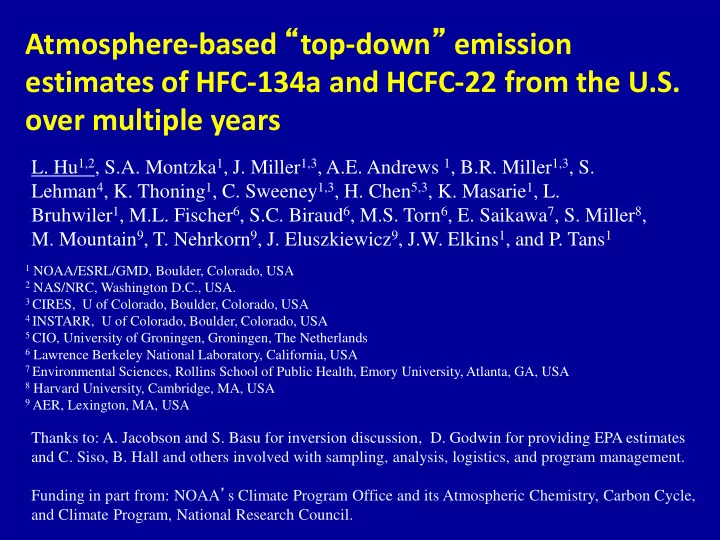

Atmosphere-based “ top-down ” emission estimates of HFC-134a and HCFC-22 from the U.S. over multiple years L. Hu 1,2 , S.A. Montzka 1 , J. Miller 1,3 , A.E. Andrews 1 , B.R. Miller 1,3 , S. Lehman 4 , K. Thoning 1 , C. Sweeney 1,3 , H. Chen 5,3 , K. Masarie 1 , L. Bruhwiler 1 , M.L. Fischer 6 , S.C. Biraud 6 , M.S. Torn 6 , E. Saikawa 7 , S. Miller 8 , M. Mountain 9 , T. Nehrkorn 9 , J. Eluszkiewicz 9 , J.W. Elkins 1 , and P. Tans 1 1 NOAA/ESRL/GMD, Boulder, Colorado, USA 2 NAS/NRC, Washington D.C., USA. 3 CIRES, U of Colorado, Boulder, Colorado, USA 4 INSTARR, U of Colorado, Boulder, Colorado, USA 5 CIO, University of Groningen, Groningen, The Netherlands 6 Lawrence Berkeley National Laboratory, California, USA 7 Environmental Sciences, Rollins School of Public Health, Emory University, Atlanta, GA, USA 8 Harvard University, Cambridge, MA, USA 9 AER, Lexington, MA, USA Thanks to: A. Jacobson and S. Basu for inversion discussion, D. Godwin for providing EPA estimates and C. Siso, B. Hall and others involved with sampling, analysis, logistics, and program management. Funding in part from: NOAA ’ s Climate Program Office and its Atmospheric Chemistry, Carbon Cycle, and Climate Program, National Research Council.
Goal: • To derive reliable “ atmosphere-based ” national emission estimates of ozone-depleting substances (ODSs) and greenhouse gases (GHGs) • To assess inventory-based “ bottom-up ” estimates Today, regional inverse modeling of HFC-134a and HCFC-22. HFC-134a: • A potent GHG • Mainly used in mobile air conditioning to replace CFC-12 HCFC-22: • An ODS and potent GHG • Mainly used in commercial and residential air conditioning • US production and consumption currently declining Key Questions: US Emission magnitudes? Seasonality & Inter-annual variability? Emission trends?
North American Halocarbon Flask Sampling Network Daily-flask site (WGC) Model Domain enhance -ments x KUM BRW x Biweekly aircraft profiling site (CMA) Total : ~20000 measurements Study Period: 2008 – 2012 Weekly-flask site (HFM) Data in inversion : Network change: ~10000 independent observations • Fewer sites in 2008 • Reduced sampling Surface and aircraft (< 1 km a.g.l.) frequency in 2012 data collected at day-time Surface sites Surface sites Biweekly aircraft profiling sites (daily flasks) (weekly flasks) Aircraft campaigns
Inversion Method Footprint (sensitivity Model-data Observed = x + of observed Flux mismatch enhancement enhancement to errors upstream fluxes ) HYSPLIT- NAM12 (2008 – 2012) STILT-WRF (2010) Solve for: monthly 1 o × 1 o scaling factors for a prior emission field using a Bayesian inversion
Synthetic-data inversion Objective: To test the credibility of our inversion system to derive national fluxes, given our sampling network Design: A forward calculation: Actual sampling times and locations as real measurements “ True ” + Gaussian emission x Footprints Pseudo observations Noise (pseudo enhancements) An inverse calculation: + + Pseudo Prior Posterior Footprints observations emissions emissions Different emission ? magnitudes and “ True ” Posterior distributions than emissions = emissions “ true ” emission
“ Truth ” & Priors & Posteriors “ Truth ” & Priors
Real-Data Inversion: HFC-134a and HCFC-22 Real-Data Inversion: HFC-134a and HCFC-22 Real-Data Inversion: HFC-134a and HCFC-22 (Multiple Priors) (Multiple Priors & Backgrounds & Transports) (Multiple Priors & Backgrounds) * Multiple a-seasonal 100 100 100 100 HFC-134A (Gg/y) HFC-134A (Gg/y) HFC-134A (Gg/y) HFC-134A (Gg/y) priors Prior = EDGARv4.2 80 80 80 80 Prior = EDGARv4.1 60 60 60 60 * Inversion results: 40 40 40 40 Prior = Population-Based bkg = 10 th prtile, 20 20 20 20 HYSPLIT-NAM12 HFC-134A 0 0 0 0 2008 2008 2008 2008 2009 2009 2009 2009 2010 2010 2010 2010 2011 2011 2011 2011 2012 2012 2012 2012 2013 2013 2013 2013 bkg = “ Curtain ” + 100 100 100 Air back-trajectory HCFC-22(Gg/y) HCFC-22(Gg/y) HYSPLIT-NAM12 80 80 80 60 60 60 bkg = 10 th prtile, Prior = Population-Based STILT-WRF 40 40 40 Prior = Saikawa et al (2012) 20 20 20 HCFC-22 0 0 0 2008 2008 2008 2009 2009 2009 2010 2010 2010 2011 2011 2011 2012 2012 2012 2013 2013 2013
Evaluating derived fluxes HFC-134a Independent Data
Comparison with other national estimates Transportation (Tg C yr -1 ) 100 100 100 700 “ Bottom-up ” : HFC-134A (Gg/y) HFC-134A (Gg/y) HFC-134A (Gg/y) 650 80 80 80 U.S. EPA ( ) 600 60 60 60 EDGARv4.2 ( ) 550 Fossil Fuel 40 40 40 500 CO 2 Emission 20 20 20 (US EIA) 450 HFC-134a 0 0 0 400 “ Top-down ” : 2000 2000 2000 2002 2002 2002 2004 2004 2004 2006 2006 2006 2008 2008 2008 2010 2010 2010 2012 2012 2012 Millet 2009 ( ) Commercial (Tg C yr -1 ) 100 100 100 700 Stohl 2009 ( x ) Residential and 650 HCFC-22 (Gg/y) HCFC-22 (Gg/y) HCFC-22 (Gg/y) Barletta 2011 ( ) 80 80 80 Saikawa 2012 ( ) 600 60 60 60 Miller 2012 ( ) 550 40 40 40 Montzka 2013 ( ) 500 20 20 20 This study ( ) 450 HCFC-22 0 0 0 400 2000 2000 2000 2002 2002 2002 2004 2004 2004 2006 2006 2006 2008 2008 2008 2010 2010 2010 2012 2012 2012
Conclusions • Synthetic-data inversion: Given our sampling network, derived fluxes using our inversion system are fairly insensitive to priors on a national scale. • Real-data inversion: - Derived national emissions of HFC-134a and HCFC-22 are fairly insensitive to priors, backgrounds and transports (within 1sd = ± 20%). - Seasonally varying emissions: winter emissions are 20 – 50 % lower than summer emissions for both gases. - Comparing to US EPA national emission estimates: - HFC-134a: comparable. - HCFC-22: ~10 – 50% lower; a relatively more rapid decline. • Future work: apply to other gases (e.g. other HFCs, HCFCs, N 2 O, CH 4 )
Evaluating derived fluxes HFC-134a AMT AMT Best Fit 1:1 line 1:1 line Simulation (prior) Best Fit Prior Posterior (RMSE = 11.8) (RMSE = 3.5) Simulation Simulation (post) (post)
Recommend
More recommend